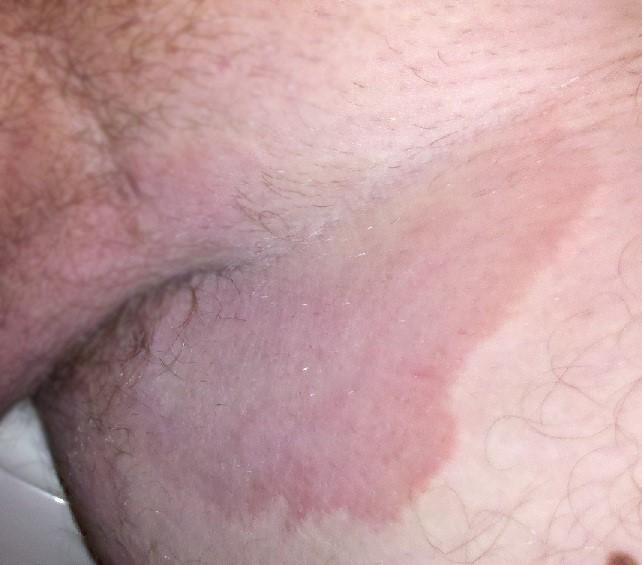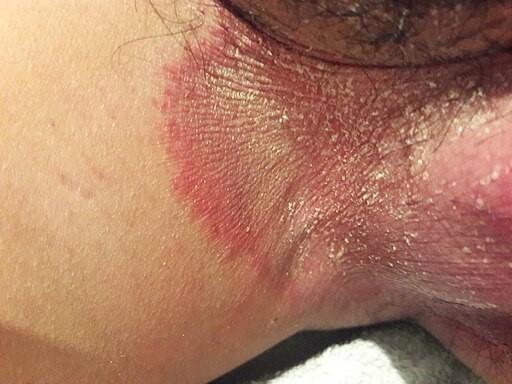Fungal groin infection
Tinea cruris
Peer reviewed by Dr Toni Hazell, MRCGPLast updated by Dr Philippa Vincent, MRCGPLast updated 9 Jan 2025
Meets Patient’s editorial guidelines
- DownloadDownload
- Share
- Language
- Discussion
In this series:Fungal infectionsAntifungal medicationThrush in menAthlete's footYeast infectionRingworm
Fungal groin infection (tinea cruris) is an infection of the skin of the groin caused by a fungus. It is a common problem, particularly in athletes and in the elderly. Treatment with an antifungal cream usually works well. The tips given below may help to prevent recurrences.
In this article:
Continue reading below
What is tinea cruris?
Tinea cruris is a fungal skin infection of the groin. Some types of fungal germs (fungi) are commonly found on human skin. These fungi usually cause no problems. However, under certain circumstances, they can multiply and cause an infection. The most common fungus causing a fungal groin infection is trichophyton rubrum.
The conditions that fungi like best are warm, moist and airless areas of skin. This includes the groin, the armpits and the area under the breasts.
Fungal skin infection is also known as intertrigo. This is a word that means "between" and "rubbing". The fungal infection is more likely to take hold because there is so much skin-to-skin contact in these areas - in the groin this is where the scrotum rubs on the skin of the thighs or the thighs rub together.
Tinea cruris in the groin is sometimes called "jock itch" because it is common in athletes. This is because the groin tends to become warm and moist during sports activities.
What does tinea cruris look like?
Fungal groin infection (tinea cruris)

By Robertgascoin (Own work), via Wikimedia Commons
Jock itch

Gerardolagunes, CC BY-SA 3.0, via Wikimedia Commons
Continue reading below
Tinea cruris symptoms
Symptoms of tinea cruris include:
Itchiness. The groin becomes itchy and can be sore, mainly in the crease between the top of the leg and the genitals.
Scrotum. In men the scrotum may also be itchy or sore.
Redness. The skin in the groin area becomes red and slightly scaly. There is usually a definite edge or border. Both sides are commonly affected.
Spreading away from the groin. The rash often spreads a short way down the inside of both thighs.
Smell. Sometimes a musty yeasty smell is noticeable.
Sometimes the infection spreads to the skin on other parts of the body (or may have first started in another area, such as athlete's foot (tinea pedis)). Fungal infections usually remain on the skin and do not usually go deeper into the body; they are not usually serious.
Fungal groin infections are more common in men than women.
When to see a doctor about tinea cruris
Medical advice should be sought if:
The rash is painful or a fever develops.
The rash has not improved after a week or two of using a topical antifungal medicine as recommended by a pharmacist.
The rash hasn't cleared up fully after three weeks of treatment.
People with a weakened body defence (immune system), eg, diabetes or having chemotherapy, may need more treatment so should seek medical advice sooner if the rash is not improving.
Risk factors for fungal groin infection
Diabetes.
Obesity.
A weakened immune system.
Continue reading below
Tinea cruris diagnosis
Appearance. The diagnosis can usually be made by the features of the rash which is usually obvious.
Skin scrapings. Occasionally, if there is doubt about the diagnosis, skin scrapings can be sent to the laboratory to identify features that would indicate a fungal infection.
Skin biopsy. If there is any concern about the diagnosis then a specialist (dermatologist) referral may be made. This would be unusual. Occasionally a skin biopsy may be required.
Tinea cruris treatment
Self-care.
Wear loose-fitting clothes made of cotton or material designed to keep moisture away from the skin.
Avoid tight-fitting clothes such as leggings.
Maintain good hygiene by washing the affected skin areas daily.
Dry thoroughly after washing, especially in the skin folds.
Avoid scratching which may spread the infection to other sites.
Do not share towels, and wash them frequently, to reduce the risk of passing on the infection to someone else.
Wash clothes and bed linen frequently to get rid of any fungal spores.
If a child is affected, it is not necessary to exclude them from school or nursery.
Topical antifungal creams. A topical antifungal cream can be used if there is mild, non-extensive disease. Options include:
Treatment with a topical antifungal cream may be repeated in the future if there are recurrent episodes of mild, non-extensive disease. An antifungal powder can be used (eg, miconazole) but creams are recommended as being more effective.
Steroid cream. A mildly-potent topical corticosteroid can be used in addition to a topical antifungal cream if there is associated marked inflammation, eg, hydrocortisone 1% cream, applied once daily for a maximum of 7 days. A topical corticosteroid preparation should not be used alone as it can make the fungal infection worse.
Oral antifungal treatment. For severe or extensive disease, adults can be prescribed oral antifungal treatment, such as:
Oral itraconazole or oral griseofulvin can be used if terbinafine cannot be used or causes any side effects.
A child with severe or extensive disease would be referred to a specialist (paediatric dermatologist).
Tinea cruris outcome
Tinea cruris usually clears up in 1 to 3 weeks with treatment, including antifungal creams. However, for people who are particularly susceptible, such as athletes and those who sweat a lot, recurrences are common and the problem may become long term (chronic).
Preventing recurrent tinea cruris
To prevent any recurring tinea cruris (fungal groin infection) self-care should be used, as outlined in the treatment above:
Wash the groin daily; then dry thoroughly. Drying is the most important part of this. It is very important to delay putting on underwear until the groin is fully dry. The damp groin is then an ideal site for fungi to multiply. A hairdryer is very useful to dry the area if the groin is more hairy or difficult to dry. However, ensure that the hairdryer is not too hot.
Change underwear daily. Fungi may multiply in flakes of skin in unwashed underwear.
Check for athlete's foot (tinea pedis) and treat it if present. Athlete's foot is a common fungal infection of the toes. In a typical case of athlete's foot, the skin between the toes is itchy and flaky - especially between the outer two toes. The fungi from athlete's foot may spread to the groin. The same creams are used to treat athlete's foot and tinea cruris.
Do not share towels with people in communal changing rooms. Wash towels frequently.
Do not share towels if suffering from tinea cruris.
Patient picks for Fungal infections

Infections
Fungal lung infections
A fungus is a tiny type of germ that usually doesn't cause any problems. They are all around us: you can only see them with a microscope. But in some situations, particularly if you have other serious illnesses, fungi (the plural of fungus) can infect your lungs. This can be very serious and requires specialist care.
by Dr Colin Tidy, MRCGP

Infections
Yeast infection
A yeast infection is usually not serious and is usually easily treated with an antifungal cream.
by Dr Hayley Willacy, FRCGP
Further reading and references
- Fungal skin infections; DermNet NZ
- Fungal skin infection - body and groin; NICE CKS, July 2023 (UK access only)
- Tinea corporis (body), cruris (groin) and incognito (steroid exacerbated); Primary Care Dermatology Society.
Continue reading below
Article history
The information on this page is written and peer reviewed by qualified clinicians.
Next review due: 8 Jan 2028
9 Jan 2025 | Latest version

Ask, share, connect.
Browse discussions, ask questions, and share experiences across hundreds of health topics.

Feeling unwell?
Assess your symptoms online for free
Sign up to the Patient newsletter
Your weekly dose of clear, trustworthy health advice - written to help you feel informed, confident and in control.
By subscribing you accept our Privacy Policy. You can unsubscribe at any time. We never sell your data.